Skin imperfections may show up in the face in varying pigmentation and size. A common kind of black patch on the skin is melasma. Even if these are common, especially to women, there are lots of ways to effectively reduce and get rid of their appearance!
Melasma: Overview of These Black Patches on the Skin
Among the many skin blemishes and hyperpigmentation is melasma. Melasma is a brown, gray, or black patch of hyperpigmentation commonly developing on the cheeks, forehead, and nose. Sometimes, you can develop it in your neck, shoulders, and upper arms as these are usual spots exposed to the sun’s rays.
Most people developing these black patches are women and those living in places with lots of sun exposure. Furthermore, melasma is prevalent in pregnant women. Some say that it is due to hormonal changes, while some believe that a woman’s genetic predisposition increases their chances of developing melasma.
Despite being common, melasma is somehow difficult to get rid of. The patches develop from the accumulation of the skin’s melanocytes or pigment cells. When these pigment cells are triggered by factors like sun exposure, hormones, or genetics, they produce more cells than normal. Hence, these are seen from the top layer of the skin as dark-colored patches.
You can consult with a dermatologist if you have melasma or other hyperpigmentation on the skin. The consultation will help you determine the kind of skin problem that you are dealing with, its underlying cause, and possible treatment.
The dermatologist may use devices like a Wood’s lamp to confirm your skin’s diagnosis. Or, when the diagnosis is unclear, the dermatologist can also perform a skin biopsy. With a correct diagnosis, the dermatologist can recommend the most efficient treatment plan to reduce and get rid of the pesky pigments.
How to Reduce and Get Rid of Melasma
Treatment of melasma varies per individual. In some people, melasma can resolve on its own without the need for any intervention. For instance, pregnant women can see significantly fewer black patches on their skin after they deliver their babies. Similarly, people having hyperpigmentation as a result of taking certain medications will naturally fade away once they stop taking that medicine.
Unfortunately, getting rid of melasma is not easy for people with hormonal issues or genetic predisposition to it. So, it is expected for them to
Most of the time, treating melasma aims to decrease the amount of pigment that the skin makes and to even out the skin tone to produce a fresh and flawless complexion. Aside from this, you can modify your treatment plan depending on the goal that you specifically want to achieve.
If you are bothered by the appearance of melasma and you are finding ways to lighten or get rid of it, here are some things you can do:
Protect your skin from harsh sunlight.
UV rays from sun exposure push the skin to make more pigment cells. If you have existing melasma, this will cause further darkening of your hyperpigmentation. Or, you can even risk dealing with even more new patches!
Sun protection may significantly reduce the risk of darkening of hyperpigmentation. It is best to apply broad-spectrum sunscreen containing at least SPF30. You would also need to reapply it throughout the day especially if you feel like you will be outdoors for a long period.
Effective sunscreen should contain active ingredients such as iron oxide, titanium oxide, and zinc oxide. Find a sunscreen that works for you, and religiously stick to using it whenever you go out!
Furthermore, wearing long clothing and wide hats can also minimize your skin’s direct exposure to UV rays. Try sticking with long sleeves, pants, or long skirts. This way, your skin is physically covered when going out under the sun.
Use topical skin-lightening medications.
If your main problem is black patches on the skin, then your dermatologist would highly recommend the use of skin-lightening creams. Hydroquinone, niacinamide, tranexamic acid, cysteamine, and much more are usual ingredients that effectively reduce pigmentation and inflammation of the skin.
However, note that some of these ingredients are not safe for pregnant women. Always consult with a dermatologist to prevent problems with the ingredients that you will apply to your skin.
Consider getting chemical peels.
Chemical peels, when done correctly, can enhance the complexion and reduce melasma. A chemical solution is applied on the skin and this removes the excess pigment.
Glycolic acid, salicylic acid, and alpha-hydroxyl acids are some chemicals used in these kinds of peels. These ingredients remove the top layer of the skin which holds most of the unwanted excess pigment. When taken correctly, chemical peels can superficially lighten melasma.
However, chemical peels do not work on the actual reduction of pigment in the skin’s deep layers. So, it is best used in conjunction with other treatments. Plus, it may cause relapse when the treatment plan for chemical peels is not completed.
Try professional laser therapy.
Laser therapy is another treatment for melasma that lightens the patches by destroying pigments in the skin. When used with other treatments, you can see significant lightening of black patches on the face. But, note that pigmentation may relapse if the use of laser therapy is halted abruptly.
Have micro-needling sessions.
Micro-needling is a minimally invasive treatment option for melasma. This time, a professional creates tiny tears in the skin using a sterile device. By inducing these small cuts, the skin will naturally heal. But this time, it will produce better skin tone thereby reducing the appearance of melasma.
Use makeup to hide the hyperpigmentation.
What would be the instant way to reduce the appearance of melasma? You can use makeup to cover it up! This is in no way a permanent solution to it as this only temporarily covers up the black patches for something like a special event, a pictorial session, or simply having your usual day.
If you have existing melasma treatment and would still like to apply makeup to feel more confident about your skin, you need to correctly layer the things you apply on your face.
After cleansing your face, apply your melasma medication. This may be your dermatologist’s prescribed topical cream or other skin-lightening products. Then, apply your sunscreen. This barrier will prevent the harmful UV rays from further darkening your melasma. And lastly, apply your camouflage makeup as you normally would.
This is a foolproof way to keep using your melasma medication and cover up any unwanted blemishes with the makeup of your choice.
Pynocare for Melasma
A promising solution to fade and get rid of melasma is the use of an orally taken medication called Pynocare. Pynocare is an FDA-approved medicine for melasma that can effectively reduce hyperpigmentation of the skin.
Pynocare contains Vitamin A, C, E, and procyanidin. The combination of these ingredients gives you antioxidant properties, protection against sun damage, improved skin elasticity, and regulated skin pigment production.
In a prior study conducted on Filipino women, a significant reduction of melasma was observed within 8 weeks of continued use. However, the same study still recommends this regimen for taking Pynocare – twice a day for around 8 to 12 weeks. The key here is consistency! Results will take weeks and months before you can confidently say that the medication worked.
As much as Pynocare is effective, it is also very safe! There have been minimal reports of side effects when Pynocare was used for treating melasma. Just keep in mind that your treatment outcome will depend on numerous factors, including management of risk factors, minimizing sun exposure, and considering hormonal and genetic predisposition.
Conclusion
Black patches on the skin are possible causes of less confidence in one’s appearance. Melasma is common in women, but this does not mean that it is untreatable.
You can always opt to seek a professional consult to help you manage your specific skin concern. And, go for safe and effective treatment options like Pynocare!
References:
- https://www.wecareforskin.net/common-skin-conditions/melasma
- https://pynocare.ph/5-pynocare-reviews-to-convince-you-to-try-it-for-your-melasma/
- https://www.aad.org/public/diseases/a-z/melasma-treatment#:~:text=Tranexamic%20acid%3A%20You%20may%20apply,you%20take%20twice%20a%20day.
- https://my.clevelandclinic.org/health/diseases/21454-melasma
- https://pubmed.ncbi.nlm.nih.gov/19659873/
- https://www.health.harvard.edu/blog/melasma-what-are-the-best-treatments-202207112776#:~:text=The%20most%20commonly%20used%20treatments,%2C%20rucinol%2C%20and%20tranexamic%20acid.
———————————————————————————————————————————————————————
PYNOCARE (Procyanidin + Ascorbic Acid + Betacarotene + d-Alpha-Tocopheryl Acetate)
The first and only oral medicine that is clinically proven to reduce Melasma or dark spots formation in just 8 weeks. Unlike creams, lotions, and gels, it has MSCC or Melasma Skin Clear Complexion Complex formulation that deeply penetrates the inner layers of the skin, to help normalize melanin levels, thus minimizing the appearance of dark spots in a short time.
Mega Lifesciences Limited Inc. or Mega We Care, is actively involved in helping millions of people have access to safe, effective, world-class quality nutritional & herbal supplements, OTC, and ethical products.

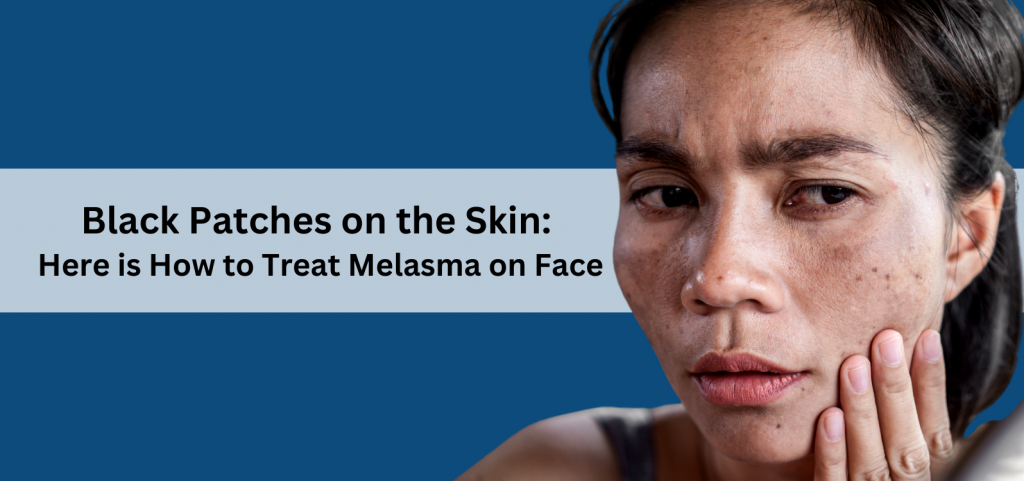
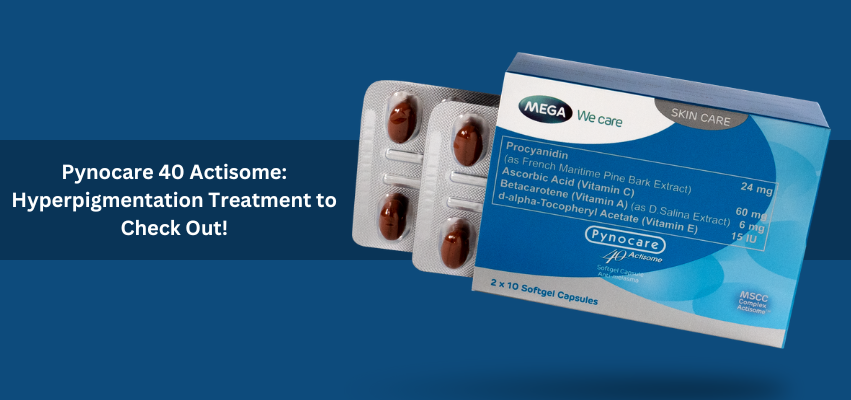
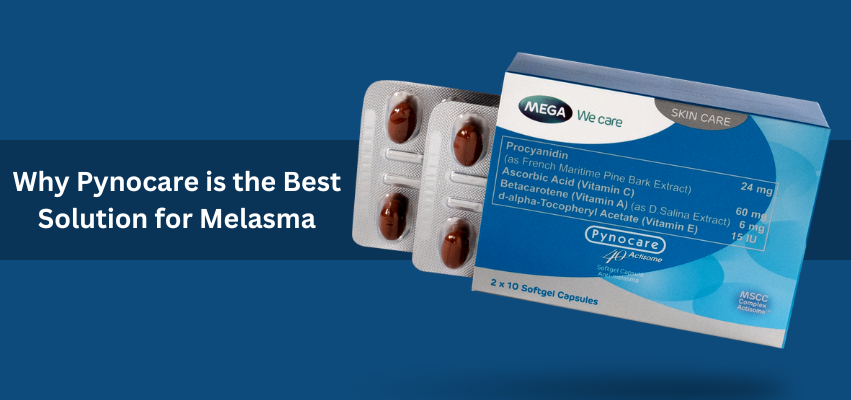
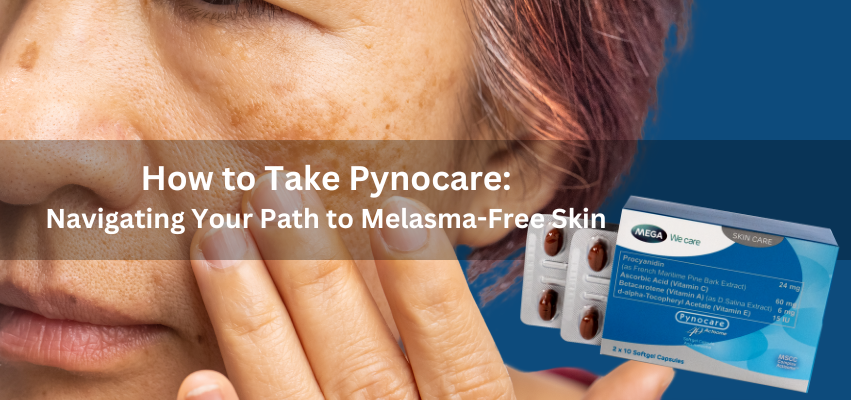


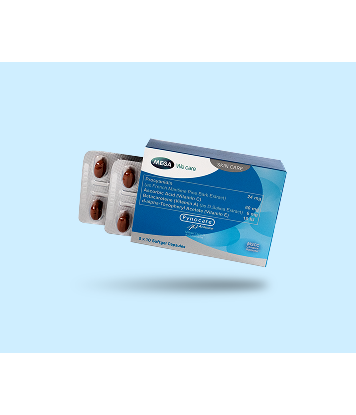











No Comments on Black Patches on the Skin: Here is How to Treat Melasma on Face